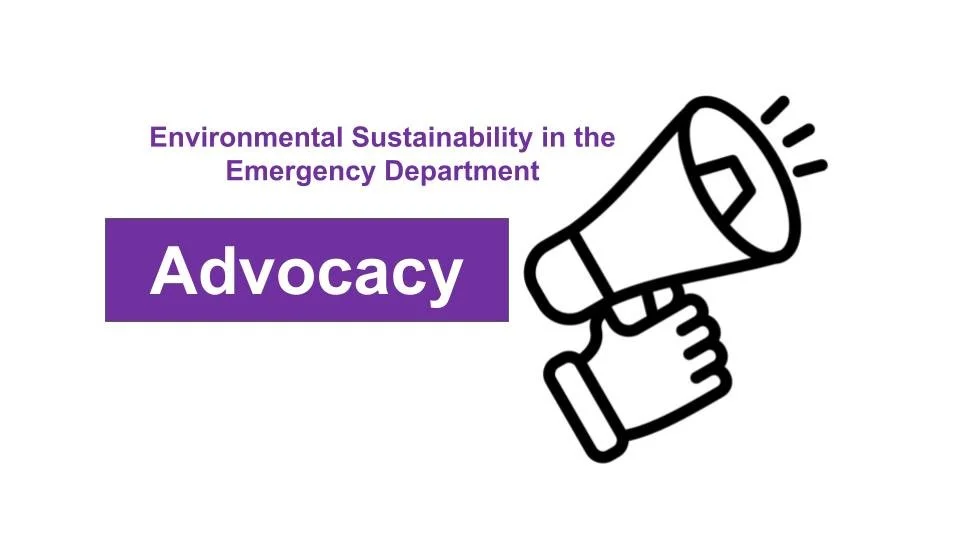Written by: Sasha Becker, MD (NUEM ‘27) Edited by: Alex Reardon, MD (NUEM ‘26)
Expert Commentary by: Ted Shieh, MD
Expert Commentary
Thank you, Drs. Beckers and Reardon for bringing awareness to an overdue and under-addressed issue in ED care. While healthcare world-wide contributes to 4.4% of greenhouse gas emissions (GHGe), US healthcare contributes to twice that percentage, in a country where each citizen generate 17.9 tons of CO2e per year compared to 6.8 tons globally. Despite the disproportionate use of resources compared to other developed countries, US healthcare patient health outcomes lag behind. With pressures to reduce cost in healthcare, sustainable practices reduce carbon emissions and pollution while maintaining quality of care, and will be a critical part of the solution to the bottom line.
Studies that have evaluated the source of CO2 emissions in healthcare tell us that Scope 3 emissions, i.e. indirect emissions, make up the overwhelming majority (up to 82%) of total healthcare emissions. In the ED, much of this translates to what we clinicians use, how we use them, how and what we prescribe to our patients. While more studies on ED specific emissions are needed to better understand how to prioritize changes in practice and operations to reduce climate impact, studies so far shed light to a number of clinical opportunities to reduce emissions as the authors have pointed out.
For example, Regulated Medial Waste (RMW), such as sharps boxes and red bag waste, require much more distance to transport to medical waste incineration sites, hence exponential cost and emissions, compared to landfill or recycling. ED studies have shown that ED generate a LOT of waste, and of that more than 85% of the discarded material in red bags did not meet the criteria for regulated medical waste and therefore did not need red bag disposal.
But compared to waste related emissions, purchased goods and services constitute a much greater percentage of overall emissions (41% of overall healthcare emissions!) Unused and overuse of medical equipment and supplies constitute a significant percentage of waste generated in the ED. ED training on proper use of RMW/red bags and other “Reduce, Reuse, Recycle” strategies mentioned above can greatly reduce waste and purchasing related cost and GHGe.
Reducing pharmaceutic waste, over prescribing, and climate impact of propellants from metered dose inhalers (MDIs) are other opportunities for ED clinicians. Pharmaceuticals constitute another significant component of Scope 3 emissions in healthcare (10% of total healthcare emissions) and its waste and overuse are within control of clinicians. Minimizing use of MDIs (each canister used and disposed of improperly result in the equivalent of an average car emission over 2 days) and choosing a powdered inhaler (DPI) instead, or incinerating used/expired MDIs can reducing greenhouse gas impact of inhalers by over 50%. Strategies such as regular departmental drug formulary reviews with goals of reducing drug waste, reducing over prescribing, educating patients on proper disposal-especially incinerating MDIs, are an easy win-win for cost and climate impact within control of ED clinicians. Prescribing medications using lowest effective dose and duration for each indication, dispensing just enough, are all achievable using preset prescriptions preference list built into your EMR to make best practice easy to implement. Patient instructions on best practice of medication disposal should also be standard of care.
Motivated to do more? How about switching (back) to reusable instruments, which clinicians prefer? Less waste, lower cost, less plastics, better for procedures, but putting that dusty autoclave back to use will require staff training and management and operations buy-in. Before tackling this, perhaps start with a low hanging fruit; switch to tap water for wound irrigation rather than costly saline.
The questions on how to change clinical practice to reduce climate impact of our work has been actively explored by clinicians over the past decade and the work continues, with the clinical sustainability movement growing exponentially each year. To learn more and change clinical practice for the better good, join the Healthcare without Harm Physician Network, attend the annual Cleanmed conference, connect with your local state chapter of Medical Society Consortium on Climate and Health, or sign up for many of offerings by the University of Colorado Climate and Health Program.
Ted Shieh, MD Emergency Medicine, Duly Health and Care Chairman of Community Engagement on Illinois Clinicians for Climate Change
How To Cite This Post:
[Peer-Reviewed, Web Publication] Becker, S. Reardon, A. (2025, July 10. Environmental Sustainability in the ED [NUEM Blog. Expert Commentary by Shieh, T]. Retrieved from http://www.nuemblog.com/blog/emergencydepartment-sustainability.












